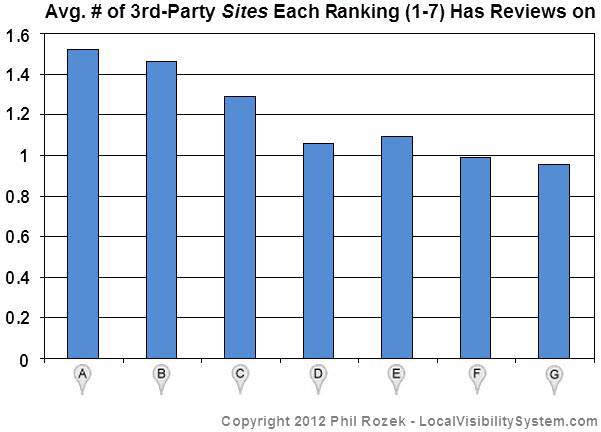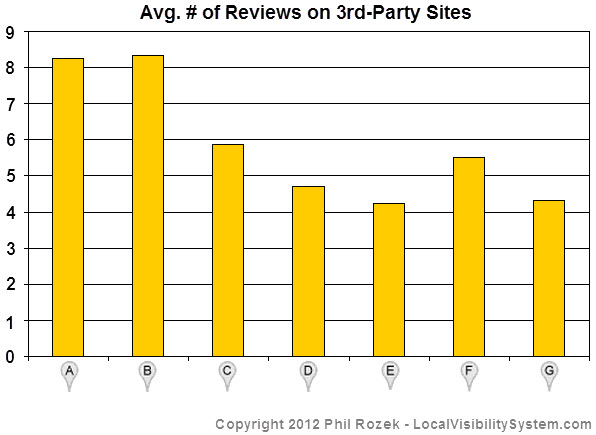Customer reviews are crucial to your local rankings and overall success in Google Places, as you may know. You need reviews that customers write directly on your Google Places page, and you need customer reviews on third-party sites like InsiderPages, CitySearch, etc.
We know that the first type of reviews—“Google reviews,” written directly on your Places page—have a strong influence on Google Places rankings. That’s well-established, and I’ve seen it to be the case throughout the 3 years I’ve been specializing in Google Local.
But what about reviews written on third-party sites? Yeah, they’re important. But what else do you know about third-party reviews and how they relate to your Google Places rankings? Probably not much more or less than I did before I did a little fact-finding on the topic.
I took a “core sample” of 200 local markets and 1400 businesses in Google Places, in all different industries and cities in the US.
(Back in July of last year I did similar research, but that was on “Google reviews” and third-party reviews collectively. This time I’m focusing on the third-party ones.)
Obviously this wasn’t exhaustive research—if it was, I’d be using my break from collecting data to shop around for some glass eyeballs. However, I’ve got enough figures to answer some specific questions about how third-party reviews tie into first-page Google Places rankings.
“How many different third-party sites does a top-7 business have customer reviews on, on average?”
When you’re on a given Places page, how many distinct sites are shown as having reviews for that business? For example:

What I wanted to know is how the number of third-party review sites corresponds to Google Places rankings. Here’s what I found:

Here are the naked numbers for the chart (that is, how many different third-party sites each ranking has customer reviews on):
A = 1.52
B = 1.46
C = 1.29
D = 1.06
E = 1.095
F = 0.99
G = 0.955
What do these numbers tell us?
First of all, there is a correspondence between the Google Places ranking of a business and how many third-party sites it has customer reviews on. Maybe you intuitively knew that already, but now you have some numbers.
The top-3 rankings have customer reviews on more sites than rankings #4-7 do. The difference is even clearer between A-B and F-G: rankings A-B generally have reviews on 1-2 third-party sites, whereas the lower rankings tend to have reviews on just one third-party site. That’s a ratio of 3:2. Put another way, the businesses at the top of the Google Places “7-pack” typically have customer reviews on 50% more third-party sites than the businesses at the bottom of the 7-pack have.
The numbers also tell us that if your business is in the top-7 of Google Places, chances are you’ve got customer reviews on at least one third-party site—meaning a medium other than Google Places or Yelp.com (because Yelp reviews no longer show up on Google Places pages).
This helps affirm what I’ve told my clients for a long time, and what Mike Blumenthal has suggested for quite a while: that you can’t simply rely on the reviews that customers write on your Places page. If you’re serious about getting a top-7 Google Places ranking, one good place to start is with asking some of your customers to write you reviews on at least one third-party site (InsiderPages, SuperPages, YellowPages, CitySearch, or another).
“How many third-party reviews does a top-7 business have, on average?”
Here’s what I found:

And again, the plain numbers for how many third-party reviews each ranking has (on average), between all the third-party sites where customers have posted reviews:
A = 8.255
B = 8.335
C = 5.87
D = 4.71
E = 4.235
F = 5.515
G = 4.325
What does this tell us?
The top-2 rankings have significantly more reviews than rankings C-G (3-7). Once again, we’re seeing a difference of 50-100% between the top of the “7-pack” and the rest of it.
Again, this doesn’t count Google Places reviews (which obviously aren’t “third-party”) or Yelp reviews (which Google Places no longer uses).
Most of all, we’ve got a couple more handy ballpark numbers that you can work into your customer-review strategy:
- If you’d like to get into the Google Places top-7, you should probably try to get at least 5 customer to write reviews on at least one third-party site.
- Or if you’re already in the local top-7 and trying to get to the very top, your strategy should include getting at least 30-100% more customer reviews on third-party sites than the other top-7 businesses have. In terms of reviews, there’s a big gap between #1 and #7.
“So how should I change my reviews strategy?”
Time for a recap. Use the following as rules-of-thumb as you move forward:
1. Don’t just focus on Google Places reviews; ask customers to review you elsewhere, too
2. There’s a correspondence between your ranking and how many third-party sites you’re reviews on. You’ll probably need reviews on one such site in order to get into the top-7. But the more different third-party sites your customers can review you on, the better
3. There’s also a correspondence between your ranking and how many total third-party reviews you have. Ranking in the top-2 will probably require that you get 30-100% more customer reviews than your page-one local competitors have.
4. If you’re trying to get into the Google Places top-7, a good initial benchmark is to get at least 5 customer reviews on at least one third-party site (SuperPages, CitySearch, etc.
5. If you want to climb higher in the Google Places 7-pack, shoot for a total of about 8 reviews on at least 2 different third-party sites
—
By the way, you can download my spreadsheet with all the data, in case you’d like to roll up your sleeves and handle some numbers.
Of course, I’d appreciate your weighing in—leave a comment!
Phil,
Great effort and an interesting study.
I’m not quite sure about the methodology though. Where did you take the data for each particular listing from? If you were checking the Place page itself, and if you did the research after the last major Place page redesign, I believe the results would be rather inexact.
After that change Google started showing only the top 3 third-party review sources in the “Reviews from around the web section” (as seen on the screenshot). One could also find the top 4 third-party review sources if checking the organic/Places SERP (at the additional side menu that could be opened for each search result). However, none of these two is the full list. Before the last update when Google hid the third-party reviews there were many listings with 10+ review sources.
Just some personal thoughts. Once again, great study and a decent reference source.
Thanks!
Hey Nyagoslav, thanks for the compliments. Great analysis of my analysis 🙂
My methodology: I did do the research after the last big update, but I didn’t get the data from the Places pages themselves; I checked the “previews” that you see from the SERPs. Which means that I was able to see the top-4 third-party sites *on which each business had reviews*.
As the spreadsheet shows, relatively very few of the businesses had reviews on 4 third-party sites, though now that you mention it, I suppose it’s possible that those businesses may have reviews on more than 4 sites (doh!).
I think the accuracy of my data depends on one question (which you brought up, of course): can businesses/Places pages with FEWER than 4 third-party review sites listed in the “preview” area actually have customer reviews on other third-party sites that *do not* show up in the “preview” area? In other words, even if the “preview” area says that a given business has (say) reviews on 2 different sites, is it possible that that business actually has many more “hidden” third-party sites where it actually *has* customer reviews?
If the answer is “no,” then some of my data–some of the “4’s” on the spreadsheet”–may be slightly off. If the answer is “yes,” then all my data is probably a bit low: for instance, maybe the average #1 ranking has 10 third-party reviews rather than 8-and-change.
So, it seems possible–maybe probably–that my numbers may be slightly low (I don’t think it’s possible for them to be high, though). Even if so, I believe the “curve” would remain pretty much the same: the top 2-3 rankings would have more reviews (and on more sites) than the lower 4-5. I saw that to be the case back in July, when I did this kind of analysis of *all* the reviews–Google and third-party combined.
With the picture: that was just a boof on my part. Even though I looked at the “preview” area for my data, I took the screenshot of the third-party sites listed on the Places page. I’ll get a different pic up there ASAP. Good catch!
Didn’t mean to write a book just now, but, long story short, I’d be really interested in knowing what you know about my “hidden review site” question (I’ll probably look into it myself also).
Thanks!
Would you ever consider doing this same type of study based a couple of different factors?
1. What effect having the owner of the the Google places page has when they do reviews of other businesses within their same geographical location.
2. What effect on ranking does the development of a Google profile have on a Google Places page listing.
3. How important is a businesses geographical information on page ranking.
Maybe you have done these test already, but I would be curious to hear your thoughts.
Thanks
Hey Jack,
Those are great ideas to do for studies. Thanks for suggesting–hadn’t thought of them in this context.
My thoughts:
1. Not sure exactly what you’re referring to here. Just a shot in the dark here, but are you wondering what effect it would have on the rankings of a given business/Places page if the owner of that business posts reviews of other local businesses?
2. I *believe* that your ranking won’t necessarily be higher if (for example) it’s 100% complete than if it’s 85% complete. Of course, if one doesn’t bother to write a “description” or pick more than one category, the chances probably aren’t as good that he/she will rank well, but that’s simply because Google looks at those aspects of your listing in order to determine how relevant your business is to your target market. Of course, it’s good to have a complete listing, but you won’t necessarily get any brownie points for it.
3. Not totally sure what you’re referring to here; I see a number of possible meanings. However, I can say that location is the single-biggest determinant of which local markets you’re visible in, and how visible you are in those markets. As I tell people all the time, you can’t take the “local” out of local search; location matters quite a lot.
Hope that helps. In any case, I’d like to do more studies along the lines of what you’re describing. They’re great questions.
Great article! Sadly I need lots of graphs to understand how all this works. In your opinion what are the best 3rd party sites to send customers to do reviews?
Thanks so much, I am totally now following you on twitter!
This might help:
https://www.localvisibilitysystem.com/2013/10/24/comparison-of-local-review-sites-where-should-you-focus-now/
Even that’s getting a little old. Ignore Yahoo. Facebook is generally a good place to encourage reviews now.
Interesting study! I’ve seen many website listings post fake reviews on their GMB profile. Do you know how Google screens for these reviews?